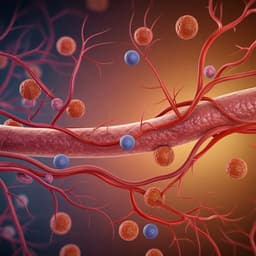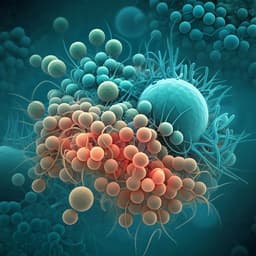
Medicine and Health
Effect of bolus enteral tube feeding on body weight in ambulatory adults with obesity and type 2 diabetes: a feasibility pilot randomized trial
E. O. Beale, W. Lee, et al.
Explore the impact of 14 days of bolus enteral feeding on weight loss in adults with type 2 diabetes and obesity. This research, conducted by Beale, Lee, Soffer, Crookes, and colleagues from the University of Southern California, found that mixed meal feeding led to significant weight loss, while the new enteral feeding tube proved to be safe and requires further development.
~3 min • Beginner • English
Introduction
Gastric bypass surgery (GB) is highly effective for obesity and type 2 diabetes but is not accessible to most candidates due to cost and safety concerns. Non-surgical methods that mimic GB’s weight-loss mechanisms could expand access. Evidence suggests GB benefits arise from activation of systemic and central pathways, with a key initiating mechanism being rapid, direct nutrient delivery to the jejunum, which stimulates appetite-suppressing gut hormones, alters nutrient/stretch sensing and vagal signaling, and affects bile metabolism, promoting a fed state and reduced intake. Prior human studies using enteral feeding have shown that post-pyloric nutrient delivery can increase GLP-1, PYY, and insulin and reduce appetite, with most studies limited to single doses or short durations. The authors previously showed that a single mixed-meal bolus delivered to the upper intestine via nasoenteral tube increased GLP-1, PYY, insulin, and suppressed appetite more than oral ingestion in adults with obesity and type 2 diabetes. The hypothesis was that repeated jejunal nutrient boluses would promote weight loss. This pilot study aimed to evaluate the effect of 14-day bolus jejunal feeding with a mixed meal versus electrolyte solution on body weight in ambulatory adults with obesity and type 2 diabetes, and to assess feasibility and safety of a novel intraorally anchored enteral tube device enabling unobtrusive, self-administered boluses during normal daily activities.
Literature Review
The study builds on literature indicating that bariatric/metabolic surgeries, including gastric bypass, induce weight loss and improve glycemic control via mechanisms beyond caloric restriction, notably rapid post-pyloric nutrient delivery that enhances incretin and anorectic hormone secretion (GLP-1, PYY), alters gut sensing and vagal pathways, and impacts bile acids. Human trials with intraduodenal/jejunal infusions show macronutrient- and site-dependent effects on hormone release and satiety, with jejunal feeding eliciting greater increases in GLP-1, PYY, CCK compared to gastric feeding. Short-term studies (single dose to 3 days) demonstrate reduced intake and hormonal responses to intraluminal nutrients. The investigators’ prior work in adults with obesity and type 2 diabetes found acute increases in GLP-1, PYY, insulin and appetite suppression with mixed-meal bolus delivered to the upper intestine versus oral intake. These data motivated testing whether repeated bolus jejunal delivery could induce clinically meaningful weight loss over weeks in free-living conditions.
Methodology
Design: Initially a prospective randomized parallel 2-group 28-day trial, amended to a randomized, crossover pilot due to slow enrollment related to dental anchor eligibility. Participants underwent two 28-day cycles, each with 14 days of tube-in situ treatment (Days 0–14) followed by 14 days without tube (Days 15–28). Randomization 1:1 to mixed-meal (MM) or electrolyte solution (ES) bolus in cycle 1, then crossover to the other treatment in cycle 2. Those completing both randomized cycles could elect additional MM cycles.
Participants and setting: Free-living ambulatory adults with obesity and type 2 diabetes, ages 18–70, BMI >30 kg/m², on diabetes medications, average self-monitored glucose <200 mg/dL in the week prior to enrollment, and acceptable dentition/hygiene for intraoral anchor. Major exclusions: DPP-4 inhibitors or GLP-1RA use; conditions impairing spontaneous passage of an 8 Fr tube if dislodged; active esophagitis/hiatal hernia; GI bleeding risk; major illness; pregnancy/potentially fertile; protocol non-adherence; known eating disorders. Outpatient visits at the USC-affiliated Edward R. Roybal Comprehensive Health Center, East Los Angeles.
Device: Intraoral anchor: custom stainless-steel channel welded to a premade orthodontic maxillary first molar band. Tube: 8 Fr, 140 cm CORTRAK tube modified by removing dual-access port, leaving ~4-mm flange to secure on anchor; custom stainless-steel cap sealed tube when not in use. Treatment administration via 60-cc syringe with blunt tapered orthodontic-grade tip; each bolus followed by 10 cc water flush. Participants were instructed to partially withdraw (~15 cm) and reinsert tube if flow issues occurred (possible distal kinking).
Interventions and schedule:
- Day -14: Orthodontic dental separators placed around selected upper molar; participants began frequent glucose self-monitoring.
- Day -7: Size-fit intraoral anchor cemented to molar.
- Day 0: Orojejunal tube placed under electromagnetic guidance using the CORTRAK 2 Electronic Access System; no sedation/anesthesia or X-rays. Position confirmed at placement. Randomization to MM or ES; supervised test bolus.
- Days 0–14: Continue ad libitum diet and usual activities. Four daily boluses administered over 5–20 minutes, typically ~30 minutes before breakfast, lunch, late afternoon meal/snack, and evening meal/snack. Max volume 125 mL per bolus. Hydration: 1000 mL ES daily; during MM cycles, all orally; during ES cycles, 500 mL via tube (treatment) and 500 mL orally.
- Days 15–28: Tube removed; maintain symptom and glucose logs.
- Study visits on Days 0, 7, 14, 21, 28: fasting assessments, clinical review, outcome measures, supply provision.
Treatments:
- MM: Ensure Nutrition Shake (per 250 mL bottle: 220 kcal [920.5 kJ], protein 9 g, carbohydrate 33 g [15 g sugars], fat 6 g; Na 190 mg; K 390 mg). Selected based on prior demonstration of incretin/anorectic responses to upper-intestinal bolus in target population.
- ES: Unflavored Pedialyte (osmolality ~250 mOsm/kg; per liter: Na 45 mEq; K 20 mEq; Cl 35 mEq; Zn 7.8 mg; dextrose 25 g; 100 kcal [418.4 kJ]). Served as low-calorie control.
Glucose management: Participants asked to self-monitor glucose four times daily; flash glucose monitors provided when available. To mitigate hypoglycemia risk with expected caloric restriction: reduce intermediate/long-acting insulin by one-third to one-half at initiation; discontinue rapid-acting insulin and sulfonylureas; adjust doses weekly at clinician PI’s discretion.
Outcomes: Primary outcome: 14-day weight change (Day 0 to Day 14). Secondary outcomes: 28-day cycle weight change (Day 0 to Day 28), and change from Day 14 to Day 28. Emphasis shifted during the pilot to participant flow, weight measurement, and reasons for withdrawal to inform future trial design. Baseline demographics/clinical parameters recorded; clinical/device events and adverse events documented weekly. Weight measured fasting in light clothing on a calibrated scale with automated recording/printout when available.
Blinding and allocation: Participants informed of study purpose and potential for weight/glucose changes; treatment composition not discussed. Identical appearance of feeds not feasible; labels removed; participants not told which was control/intervention. Investigators not blinded; research assistant managed randomization and weight measurement; PI managed safety and glucose. Randomization by online generator; sequentially numbered sealed opaque envelopes opened after confirmed tube placement.
Sample size and statistics: Pilot anticipated greater weight loss with MM with n=10 per group based on prior caloric restriction data. Trial closed after obtaining feasibility and effect-size data for future studies. General linear model for crossover per-protocol analysis of first two randomized cycles (main effects: intervention, period, sequence; random effect: subject nested within sequence). Secondary analysis included six additional MM cycles (total 18 cycles in six participants). Paired t-tests compared baseline to final measures for participants with ≥2 cycles. ClinicalTrials.gov: NCT04215328.
Key Findings
- Enrollment/feasibility: 167 assessed; 16 enrolled (10%); 12 initiated cycle 1; 6 completed both randomized 28-day cycles and were analyzed for the primary outcome. Total of 23 two-week cycles completed (12 paired within crossover, 2 unpaired, 9 additional MM cycles) over 334 cumulative tube-days.
- Primary outcome (14-day weight change; per-protocol crossover, n=6): No significant between-treatment difference: MM vs ES p=0.082. Per Table 3, 2-week least-square mean changes: ES -1.39 kg (95% CI -3.06, 0.28), MM -2.07 kg (95% CI -3.26, -0.89); between-treatment p=0.18.
- Secondary outcomes (28-day cycle): Within-group weight loss significant for MM but not ES. 4-week least-square mean changes: MM -2.40 kg (95% CI -3.78, -1.02; p=0.008), ES -0.64 kg (95% CI -2.01, 0.74; p=0.27). Difference MM–ES: -1.76 kg (95% CI -3.71, 0.18).
- Post 14-day (Days 14–28) changes: No significant weight change on average.
- Exploratory analysis including additional cycles (12 MM, 6 ES; total 18 cycles in 6 participants): At 2 weeks, MM associated with greater loss but not significant vs ES (difference -1.39 kg; p=0.085). At 4 weeks, significant difference favoring MM (difference -1.76 kg; p=0.033).
- Safety: No significant clinical or device-related adverse events during 334 tube-days. Most common issues were minor oral anchor discomfort and transient device handling difficulties (e.g., tube kinking; resolved by partial withdrawal/reinsertion). No symptomatic hypoglycemia or hyperglycemia reported; glucose monitoring data incomplete in some cycles.
- Tolerability/retention: Ten withdrawals before completing both randomized cycles: 4 for social reasons, 3 intolerant of anchor, 3 intolerant of tube. Among those with tube >1 day, many tolerated well; six elected multiple cycles.
Discussion
Repeated, minimally invasive jejunal bolus delivery via a novel intraorally anchored tube was feasible and generally safe in ambulatory adults with obesity and type 2 diabetes, enabling self-administered feeds without restricting daily activities. While within-group analyses showed significant weight loss during MM cycles and not ES, between-treatment differences over 2 weeks were not statistically significant in the primary per-protocol analysis; at 4 weeks, MM showed greater weight loss than ES, reaching significance only in exploratory analyses that included additional MM cycles. The observation that ES cycles also yielded some weight loss suggests that jejunal distension and/or osmotic effects may contribute to satiety and reduced intake, consistent with literature on hyperosmolar duodenal saline lowering ghrelin and stimulating gut hormones. Some participants continued to lose weight after tube removal, potentially reflecting persistent intestinal mucosal or enteroendocrine changes.
Feasibility was limited by recruitment and dental anchor tolerability; improvements such as targeting populations with routine dental care, proactive use of orthodontic wax, thorough pre-procedure counseling, and initial low-calorie test feeds may enhance acceptability. Safety over nearly a year of cumulative tube use supports broader inclusion criteria and reduced visit frequency in future trials. Methodological limitations (lack of blinding, absence of ongoing confirmation of tube tip position, unmeasured adherence, and clinician-directed medication adjustments) may have biased results and limit interpretability. Future studies should incorporate double blinding with indistinguishable feeds, standardized dosing and timing, objective confirmation of tube location during use, and comprehensive assessments (food intake, gut hormones, appetite/sensations, transit, and continuous glucose monitoring) to elucidate mechanisms and optimize therapeutic protocols. Nutrient type, dose, site, and rate can then be iteratively adjusted, and findings can inform development of non-invasive nutrient-based weight-loss strategies (e.g., enteric-coated distal-release formulations).
Conclusion
Repeated bolus nutrient administration for up to 2 weeks at a time via an intraorally anchored orojejunal tube is feasible and generally safe in ambulatory adults with obesity and type 2 diabetes. MM cycles were associated with significant within-group weight loss, though differences versus low-calorie ES were not consistently significant over 2 weeks. The prototype device requires further development to improve acceptability and enable rigorous, blinded evaluation of bolus jejunal feeding as a potential therapy for weight management and obesity-related comorbidities, and to guide the development of other nutrient-based interventions.
Limitations
- Small sample size with only six participants completing both randomized cycles; pilot feasibility design limits power and generalizability.
- Lack of blinding for investigators and incomplete blinding for participants; feeds not identical in appearance; potential bias in outcomes.
- Tube tip position not confirmed after initial placement due to device modification, raising uncertainty about consistent jejunal delivery during use.
- Adherence to prescribed bolus administration not formally measured; actual delivered dose/frequency uncertain.
- Diabetes medications adjusted at clinician discretion, potentially confounding weight outcomes.
- Incomplete glucose monitoring data; many desired mechanistic measures (food intake, gut hormones, appetite, GI transit) not collected.
- Recruitment/retention challenges and dental anchor tolerability limited feasibility.
Related Publications
Explore these studies to deepen your understanding of the subject.







